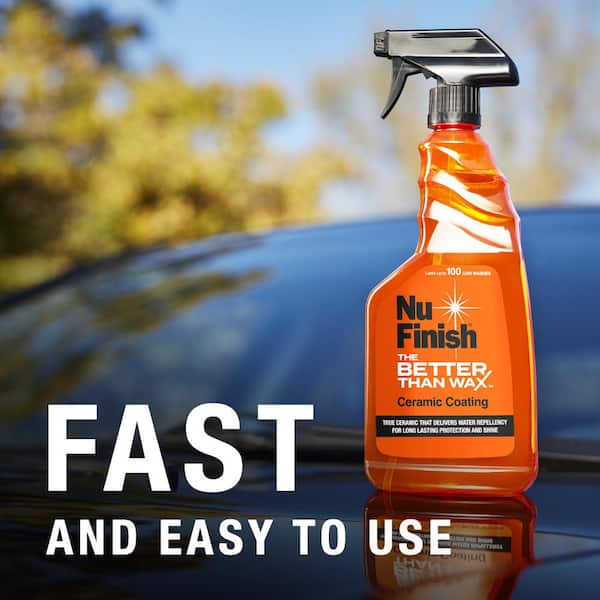Why Ceramic Finishing Is the Ultimate Remedy for a Flawless Finish
Ceramic finishing has actually arised as a leading solution for those looking for a flawless surface for their cars, thanks to its exceptional toughness and safety functions. What factors really established ceramic coating apart?
What Is Ceramic Covering?

When used appropriately, ceramic covering develops a hydrophobic surface that drives away water and dirt, making it less complicated to clean up and preserve. Unlike conventional waxes or sealants, which normally offer short-term defense, ceramic coatings can last for numerous years, relying on the item top quality and application method. The procedure of applying ceramic finish calls for precise prep work, consisting of complete cleaning and often repaint improvement, to ensure optimal bonding and efficiency.
Ceramic coatings are not limited to automobile surfaces; they can likewise be made use of on various products, including glass, metal, and plastics, offering a functional option for enhancing defense. In general, ceramic layer stands for a considerable improvement in surface area defense technology, combining both visual and practical benefits for a variety of applications.
Benefits of Ceramic Layer
While several surface defense alternatives exist, the advantages of ceramic finishing stand out because of its special buildings and long-lasting efficiency. One of the key advantages is its outstanding durability. Ceramic Coating Philadelphia. Unlike conventional wax or sealants that call for regular reapplication, ceramic layers give a durable layer that can last for numerous years, dramatically reducing upkeep efforts
An additional significant advantage is boosted defense versus ecological pollutants. Ceramic coverings create a hydrophobic surface area that pushes back water, dust, and different contaminants, making it much easier to clean up. This feature not only protects the car's appearance but likewise lessens the danger of corrosion and oxidation, particularly in severe climate condition.
Furthermore, ceramic finishes use superior resistance to UV rays, protecting against fading and destruction of paint gradually. This UV security is vital for maintaining the visual value of surface areas and automobiles revealed to route sunshine.
Furthermore, the glossy surface achieved with ceramic coating boosts the overall aesthetic charm, providing surfaces a showroom-quality shine. On the whole, ceramic finishings represent a substantial advancement in surface area protection modern technology, giving long-lasting benefits that cater to both functional and visual demands.
Exactly How It Functions
Understanding the scientific research behind ceramic finishes reveals how they provide such impressive protection and longevity. At its core, a ceramic layer is a liquid polymer that chemically bonds with the automobile's manufacturing facility paint.
The application process involves multiple steps, consisting of surface area preparation, which is crucial to achieving ideal attachment. As soon as applied, the covering undertakes a healing procedure, throughout which it solidifies and forms a semi-permanent bond with the paint surface. This bond is what distinguishes ceramic finishes from traditional waxes and sealers, providing a longer-lasting safety barrier that can withstand for several years.
Additionally, the density of the covering can improve its protective top qualities, making sure that it can hold up against rough conditions. Eventually, the scientific research of ceramic finishings incorporates innovative products with innovative application techniques to provide an exceptional level of security and aesthetic enhancement for lorries.
Contrast With Traditional Approaches
When contrasted to conventional paint security methods such as sealers and waxes,The advantages of ceramic finishings become especially apparent. While waxes supply a short-term luster, usually lasting a site web few weeks to a couple of months, ceramic coatings offer a long-lasting protective layer that can sustain for numerous years. This sturdiness substantially minimizes the regularity of reapplication, making ceramic coatings a more economical option gradually.
In addition, standard techniques often require extensive preparation and several applications to achieve an acceptable degree of defense. In comparison, ceramic layers bond at a molecular level with the vehicle's surface, developing a robust shield against ecological impurities like UV rays, acid rain, and roadway salts. This bond enhances the car's resistance to scratches and swirl marks, which are common with standard waxes and sealants.
In addition, the hydrophobic residential properties of ceramic layers repel water and dirt, causing less complicated cleaning and maintenance. On the other hand, wax and sealant-treated surfaces can bring in grime, demanding more regular cleaning - Ceramic Coating Philadelphia. Generally, ceramic layers not only supply exceptional protection yet also deliver a more long-lasting and aesthetically enticing surface, developing them as the recommended option for critical car proprietors
Application and Upkeep Tips

Using a foam applicator, use the covering in tiny sections, adhering to the supplier's standards relating to density and overlap. Allow sufficient healing time between coats, commonly 24-hour, to make sure appropriate bonding. After application, it is vital to prevent direct exposure to water or extreme elements for at the very least a week to enable the finish to fully cure.
For maintenance, wash the car on a regular basis with pH-balanced soaps and stay clear of rough materials. Touchless automobile laundries are suggested to minimize scratching. Furthermore, using a ceramic upkeep spray can boost the layer's hydrophobic residential or commercial properties and longevity. Normal inspections for any signs of wear will aid keep the coating's honesty and preserve that immaculate coating.
Conclusion
In conclusion, ceramic finish arises as a superior choice for attaining a remarkable automotive coating. By developing a robust bond with factory paint, ceramic finishing efficiently guards against scratches, UV official site rays, and ecological impurities.
